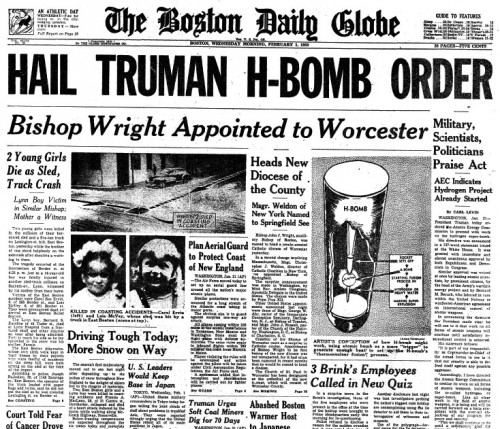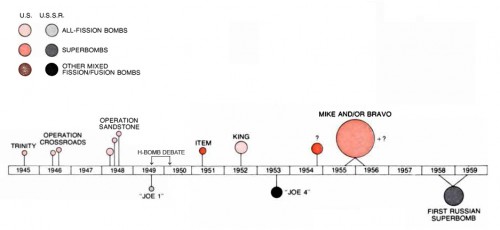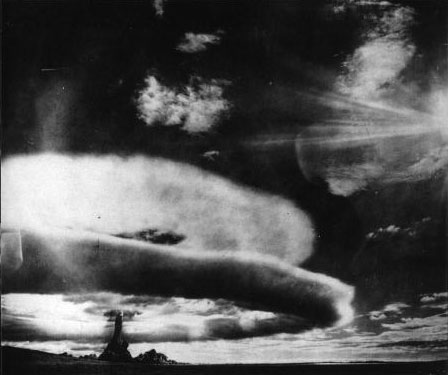The debate over the hydrogen bomb is one of my favorite Cold War episodes. I keep coming back to it, both on the blog and in my research. I’d posit that it is in many ways a lot more interesting than the debates about Hiroshima and Nagasaki. Why? Because at the time of the Second World War, there was actually very little debate about Hiroshima and Nagasaki. You basically had the Franck Report and the Targeting Committee; the former said, “don’t drop it,” and the latter replied, “who cares what you think? We’re dropping it.” As many have pointed out, the whole idea that there was a conscious “decision to drop the atomic bomb” is a bit off — it doesn’t appear that anybody who had the authority to drop the bomb agonized over the question before dropping it. What agonizing there was mostly came after the fact.
The H-bomb was something else, though. This was a technical possibility that had been seen long before the weapon was capable of being built, and there actually was a period of serious behind-the-scenes and later public debate over whether it should be built, in an era where the potential guilt of Hiroshima and Nagasaki was still palpable. A lot of scientists saw the hydrogen bomb as an opportunity for the moral debate they never had about the atomic bomb, and that makes it, to me, a much more interesting co-mingling of visions of the past and fears of the future.
The ultimate “What If?“ of the atomic bomb is, “what if they didn’t drop the bomb?” The ultimate “What If?” of the H-bomb is, what if Truman hadn’t ordered the crash program in late January 1950?
The common Cold War argument was one of technological inevitability: if the H-bomb could be built, it would be built. This was then mixed with an existential plea: it would have been “intolerable” for the USSR to have an H-bomb and the USA not to. But let’s shelve these common arguments for a minute, because, while interesting, they obscure a somewhat more basic factual question about what would have happened. I think that the incredible US superiority in both fission bombs and in delivery mechanisms would have easily deterred an H-bomb attack from the USSR, personally, and there are lots of ways to imagine the could/would transition could be avoided or stalled, but frankly, I think both of those questions are actually irrelevant to what would have occurred.
There’s a brief timeline that we all have to know to be on the same page here, so let’s just throw it out in bulleted form:
- August 1949: USSR tests its first bomb in a test the US dubs “Joe-1.” The US detects it in September. Secret debate begins within US government over whether an H-bomb should be built. Debate leaks to public by end of 1949.
- Late January 1950: Truman announces publicly that the Atomic Energy Commission should work to build an H-bomb.
- March 1951: Edward Teller and Stanislaw Ulam figure out how to make a multi-megaton H-bomb.
- May 1951: The basic principle of the Teller-Ulam design is tested at the Greenhouse GEORGE test in the Pacific Ocean. Also tested is Greenhouse ITEM, a “boosted” bomb whereby a tiny amount of fusion fuel is used to improve the efficiency of a fission bomb. “Boosted” bombs greatly increase the yield of existing weapons and/or allow you to make more weapons with less fissile material.
- November 1952: The US tests its first Teller-Ulam style H-bomb, Ivy MIKE (10 Mt). It also tests Ivy KING, the largest pure-fission weapon ever built (500 kt; half a megaton). The Ivy MIKE device is a proof-of-concept; it weighed over 50 tons. (A handful of potentially-deliverable prototypes were made based on the design, but it isn’t clear whether they were considered reliable.)
- August 1953: The USSR tests “Joe-4,” a nuclear weapon that involves some fusion reactions but was not a “true” H-bomb. It was a very big bomb (400 kt, still less than the all-fission Ivy KING), but the design could not be scaled into the megaton range. Still, a big bomb, and it could be dropped from existing Soviet bombers.
- March 1954: The US begins a test series of deliverable high-yield thermonuclear weapons, Operation Castle. Castle BRAVO, the first test in the series, was considerably larger in yield than was expected (15 Mt) and was one of the worst radiological accidents in US testing history. The US now has weaponized H-bombs in the multi-megaton range.
- November 1955: The USSR tests its own multi-megaton H-bomb for the first time (RDS-37); it is deliverable.
That’s the history we’re really concerned with. Herbert York, in 1975, wrote an article in Scientific American about this question, the gist of which was later published as a book, The Advisors: Oppenheimer, Teller, and the Superbomb (San Francisco: W. H. Freeman, 1976). Most of the book and article concern the October 1950 report by the AEC’s General Advisory Committee which was unfavorable to the idea of building the H-bomb and led to Oppenheimer’s security hearing some years later. But what I really love about the Scientific American article, as opposed to the book that came out, are his illustrated timelines. 1
The above is a modified version of the Scientific American timeline, and describes the events shown up above in bullet points. I’ve added a few small things to it — the period of the H-bomb debate itself (the endpoint is Truman’s announcement; the debate technically goes on after that though it is a pretty done deal from a policy perspective), and the asterisk on the US “side” of the timeline shows when the US learned the Teller-Ulam idea, and the asterisk on the Soviet side is supposedly when the USSR figured it out for themselves. (Exactly when the Soviets actually figured it out, and how, is a matter of some continuing dispute.) The colors indicate the bomb type as indicated by the chart (they are not as distinct in the scan as the original), and the size of the circles indicate relative yield.
I like two things about this timeline. The first is that it shows how relatively close these events were to one another — two years (say, 1950 to 1952, or 1952 to 1954) seems like a long time until you stack it up like this, when it seems almost immediate. But the other thing comes what York (or, rather, the graphics editors at Scientific American, who worked quite independently from the authors at this period of time) does next: he proposes alternate possibilities.
Let’s imagine, says, York, that Truman doesn’t order an H-bomb built. What’s the most probable outcome? Here’s what he gives in response (I’ve modified this to fit onto the “original” timeline above; in York’s it is a series of branching timelines):
In York’s view, this “most probable alternative world,” without the Truman decision, the US would still have developed ITEM (the “boosted” bomb) and KING (the all-fission bomb, which he says would have likely even been tested earlier, since the tempo of Operation Ivy was set by the time it took to get MIKE together). Let’s imagine the Soviets still tested “Joe-4,” which was, again, not a “true” multi-megaton H-bomb. York thinks that at that point, the US would have then initiated a “crash” H-bomb project, and pulled off a GEORGE-like test in late 1954, and probably a full-scale H-bomb in 1955 or 1956. (The MIKE/BRAVO distinction is whether it would have been liquid or solid fueled; hard-to-deliver or easier-to-deliver.)
Interestingly, York also thinks that the Soviets’ development of a multi-megaton H-bomb would have been delayed. Why? Because in his view they got a lot of “stimulus” from the 1952 test, knowing that it was possible to work in the first place. Once you know something is achievable, for whatever reason, you end up finding the solution pretty quickly. (This is not unlike, but not quite the same thing, as the technological inevitability argument.) There is also (but York doesn’t propose this) the possibility that the MIKE shot more directly helped the USSR in the way of fallout, as was speculated by Daniel Hirsch and William G. Mathews in the Bulletin of the Atomic Scientists awhile back now. 2 The Soviets later claimed that they bungled the fallout analysis, but one never really knows.
So in York’s “most probable” scenario, the US still would have had a real H-bomb well before the USSR. It’s hard to see “Joe-4” as creating a strong strategic imbalance, especially since the US still would have had a bomb that big ready to go (KING). OK, York says, maybe that’s optimistic. What’s the worst possible scenario? Another timeline:
In this timeline, we use the “real world” Soviet testing timeline with the “most probable” US reaction timeline. The result is that the Soviets have their first H-bomb at just about the same time that the US would have had one. That is, even in the worst-case scenario, the US and the USSR more or less have multi-megaton H-bombs at the same time. Not much imbalance to be held, especially if you take it into account that the US still had a huge advantage in fission weapons (3057 to 200 in 1955) and deliverability (bases in close proximity, long-range bombers).
All of these scenarios, of course, presume that the USSR would have soldiered on ahead with the H-bomb even if the US had renounced building it. That is, these are by definition all pessimistic scenarios — and none of them are that bad. One wonders what truly optimistic scenarios would have looked like!
I like this way of using the timelines, though it flattens a lot. Would Teller and Ulam have come up with the Teller-Ulam idea without the Truman “crash” program? There’s a lot to unpack there in terms of chronology — they didn’t come up with it by just sitting around idly. Did the “crash” program really speed up development? A big, deep, difficult question. (In other words, are the asterisks on the modified “real” timeline actually fixed positions or are they relative to other things, and if so, to what?)
But still, even while this timeline approach doesn’t quite cover all the bases, I still think it helps us play with the dates here a bit better, and visually play with the possibilities (“most probable” and “worst possible”) in a provocative way. The “flattening” effect of the timeline is by design. I’m all for thick description (as you can tell), but sometimes there’s an analytical advantage to being able to smooth things out to try and see the big pictures.
I’m more or less convinced that the world wouldn’t have ended if Truman hadn’t ordered the H-bomb’s development. Heck, even if the USSR did have exclusive possession of multi-megaton H-bombs, I still don’t see it affecting the strategic situation in a completely “intolerable” way — I don’t see the USA ever thinking its fission deterrent wasn’t able to deter. But the beauty of this way of thinking about it is that you don’t even have to have that discussion, really, because it’s not clear that possibility was ever on the table.
- Herbert York, “The Debate over the Hydrogen Bomb,” Scientific American 233 (October 1975), 106-113. A copy is reprinted in York’s Arms and the Physicist, for those who don’t have access to Scientific American back issues.[↩]
- Daniel Hirsch and William G. Mathews, “The H-bomb: Who Really Gave Away the Secret?” Bulletin of the Atomic Scientists 46, no. 1 (January 1990), 22-30.[↩]







I would extend your timeline back into the Manhattan Project and Teller’s obsession with the “Super,” which distracted from the task at hand, leading to differences between him and Oppenheimer.
The differences between the two men on these priorities and their respective political alliances were an essential part of the “debate over the hydrogen bomb.” In this post, you’re taking a broader view. But in this case, I think the effects of this personal interaction were significant.
Just a couple of years ago, I was part of a discussion in which a Teller acolyte passionately defended the technological inevitabity hypothesis. It’s still out there.
Alex,
You link to the Scientific American piece by Gennady Gorelik about the Riddle of the Third Idea. As one solution Gorelik references Thomas Reed, who with Danny Stillman wrote The Nuclear Express. Reed and Stillman claim there was a spy at Los Alamos who passed information during the Manhattan Project, stayed on after the War and then passed on the Third Idea to the Soviets. They do not name this individual but I figured it out and published it on The Huffington Post on December 30, 2008, “An American Scientist, the Soviets and the H-Bomb.” See
http://www.huffingtonpost.com/robert-s-norris/an-american-scientist-the_b_154307.html
Reed and Stillman offer no evidence to support their claim in the book or afterwards.
Since revealing who they claimed was the spy I have talked with many who knew Froman and not one agrees with them and finds it impossible to believe their tale, as do I.
Hi Stan: I remember when that came out; I immediately FOIA’d Froman’s FBI file after reading your piece. It is completely dull. If he was a spy (which I doubt), the FBI apparently never got any wind of it. In general, I don’t find the espionage idea completely impracticable (the Teller-Ulam idea is an easy-enough idea to convey, and was known fairly widely amongst the weapons designers at Los Alamos and Livermore — it’s still rather amazing to me that it was thought that it could be kept much of a secret at all once figured out), but I agree that the identification of Froman is without apparent evidence.
[…] on the hydrogen bomb is one of the most enigmatic: in early 1950, he strongly lobbied against Truman’s “crash” program. Two weeks after Truman’s announcement on the H-bomb (and the unveiling of Klaus Fuchs, which […]
[…] It wasn’t until 1956 that the declassification eventually occurred, however, and even then, a lot of things were removed. (The “Amended*” in the RAND report cover page above is because it was “Amended to remove classified data; otherwise the report remains unchanged and represents the 1953 estimate of the fallout problem.”) Of course, by that point it was clear that the Soviets had already figured out how to make an H-bomb work. […]